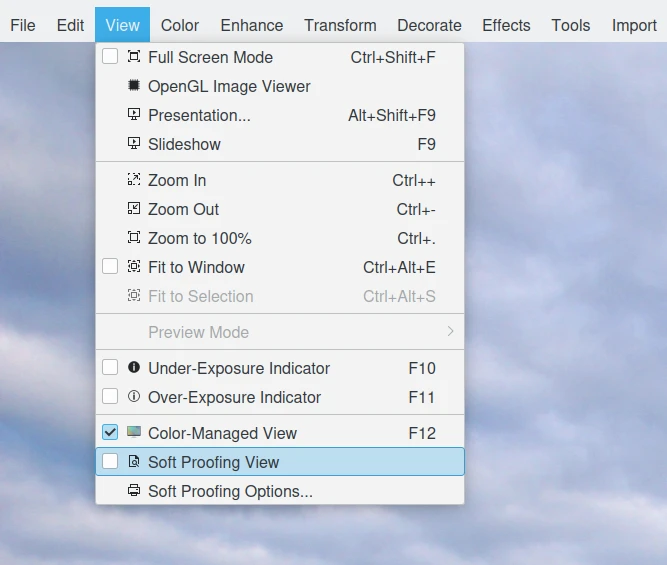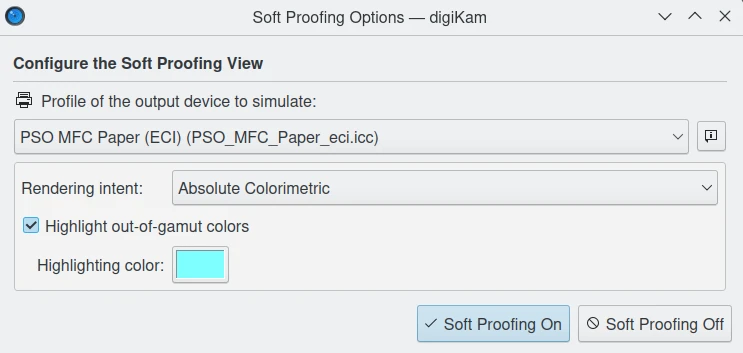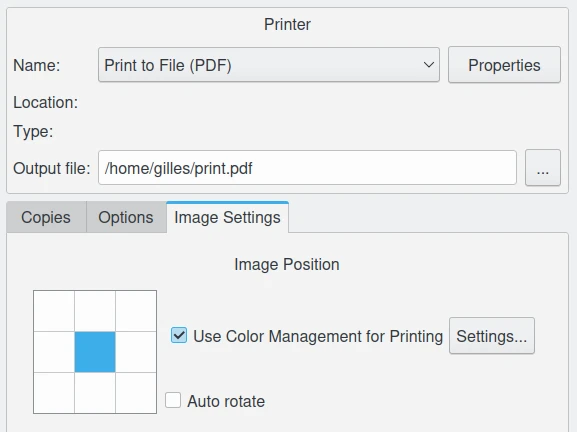打印机色彩特性文件¶
使用打印机色彩特性文件¶
你的图片已经编辑好了,准备打印了,但打印机色彩特性文件(也叫打印机颜色配置文件)从哪儿来?你已经知道答案了:可以用打印机自带的通用色彩特性文件;可以花钱买一个专业制作的色彩特性文件;一些商业打印店会提供他们的打印机色彩特性文件(不过这些只适合他们的打印机,不适合你的);或者,你可以用 Argyll 自己做一个打印机色彩特性文件,量身定制,适配你的纸张、墨水,甚至图片的特性。比如,如果你打印的是一系列颜色偏柔和棕色的图片,就不需要一个非得包含鲜艳青色和蓝色的色彩特性文件。
想在digiKam里设置默认的打印机和软校对配置文件?去 ,选你想要的配置文件。更多详情可以看看手册里的 “色彩管理设置” 部分。

digiKam 色彩管理设置对话框,用于自定义打印机和色彩校样的色彩特性文件¶
色彩校样¶
色彩校样(软打样、软校样)能让你在屏幕上预览打印出来的效果,了解屏幕显示和实际打印之间的差异。想色彩校样,你得有个打印机色彩特性文件(其实是打印机和纸张组合的色彩特性文件,因为纸张会影响墨水颜色和白点)。如果色彩校样后的效果不满意,你可以在工作空间里调整图片,再转换到打印机空间。
在图像编辑器里启用色彩校样,点 就行。

digiKam 图像编辑器的色彩校样菜单选项¶
如下图所示,色彩校样的选项可以通过在图像编辑器里选择 来设置。

digiKam 图像编辑器的色彩校样选项菜单¶
感知 渲染意图在色彩校样时不一定是最好的选择,这取决于图片和打印机/纸张组合的色域。通常,色度 渲染意图能带来更清晰、更明亮的颜色,但得小心重新编辑图片,避免高光和阴影被裁剪。所以,虽然 感知 渲染意图意图总是个选项,但不一定是“最优”的。
感知 渲染意图是个“安全”选择,因为它能防止阴影和高光被裁剪,不过可能会让颜色整体变淡。如果你懒得做色彩校样,直接选感知渲染意图(而且可能也该继续用 sRGB)。
黑点补偿¶
黑点补偿 用来调整 数字文件最大黑色等级 和 打印机等数字设备黑色能力 之间的差异。
如果想打开或关闭黑点补偿,可在 。更多详情可以看看手册里的 “色彩管理设置” 部分。
黑点补偿的效果因情况而异。试试开启黑点补偿做色彩校样,喜欢就用,不喜欢就不用。

digiKam 图像编辑器的打印功能支持使用你喜欢的打印机色彩特性文件,并调整黑点补偿¶